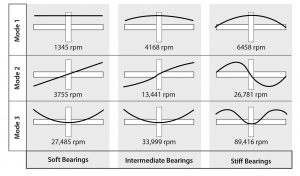Rotordynamic Analysis

A process that considers the interaction between the elastic and inertial properties of the rotor and the mechanical impedances from the fluid-film bearing supports, oil seal rings, seals, etc. The detailed study of rotordynamics demands accurate knowledge of the particular mechanical elements supporting the rotor, such as fluid-film bearings and seals.
The most commonly recurring problems in rotordynamics are:
- Excessive steady-state synchronous vibration levels. Steady-state vibration levels may be reduced by improving balancing, modifying rotor-bearing systems: tune system critical speeds out of revolutions per minute operating range, or introducing damping to limit peak amplitudes at critical speeds that must be traversed.
- Subharmonic rotor instabilities. Subharmonic rotor instabilities may be avoided by raising the natural frequency of the rotor system as much as possible, eliminating the instability mechanism by changing bearing design if oil whip is present, or introducing damping to raise onset speed above the operating speed range.
